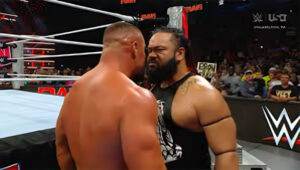Nearly 60 years ago, one of the most influential wrestlers of all time had his final match. On November 7, 1962, Gorgeous George had the final match of his career in a hair versus hair match, that George lost. His Samson moment was one of ultimate defeat, and sadly his career and life were cut short soon after, leaving the removal of his greatest asset as the final definition of his career.

George Wagner got his start in professional wrestling in 1932, but despite being an above average wrestler, his look was a dime a dozen and he struggled to find his footing in the burgeoning Golden Era of pro wrestling. But after reading about ‘Lord’ Patrick Lansdowne in Vanity Fair, a man who wore lavish robes and had two valets enter him into the ring, George was inspired to take this model even further. Bleaching his dark hair a platinum blonde, with his wife, Betty, creating outlandish robes, all while accompanied by his man servant Jeffries, who would pre-spray the ring with expensive cologne.

Redubbed Gorgeous George, he would go on to create a blueprint that is imitated today – the bleach blonde hair, the extravagant robes, the disdain for the common man – that has carried throughout the years with the likes of Buddy Rogers, Ric Flair, “Adorable” Adrian Adonis, and more. For decades, he was wrestling’s biggest heel, an affront to American “manhood” who exuberated an arrogance instead of a humble sportsman and a pomp and circumstance that made you hit him the minute you laid eyes on him. A tour of Canada working for Stu Hart‘s Klondike Wrestling (later to be renamed Stampede Wrestling) led to the next addition to his arsenal of heat – upon Helen Hart‘s suggestion, he added theme music, in the form of Sir Edward Elgar‘s composition “Pomp & Circumstance”.
Throughout the television age of the 1950s, few could attract viewers waiting to see him get his comeuppance than Gorgeous George. The revelry from the crowd was so great that George hardly needed titles to get himself over – much like heels like Rowdy Roddy Piper, George transcended championship belts. Fans loved to hate him but he made more money in defeat than in winning gold. But that’s not to say that George was devoid of championship opportunities – he challenged Lou Thesz and Whipper Billy Watson on several occasions for the NWA World’s Heavyweight Championship. But George was not dependent on one promotion or banner – he also challenged Enrique Torres, Edouard Carpentier, and Freddie Blassie for the World Wrestling Alliance (WWA) World Championship. But he was not without his championships – in 1950, he won the American Wrestling Association (AWA) World Heavyweight Championship (the Boston AWA, not the one associated with Verne Gagne in Minnesota years later).
In 1949, he became a Hollywood star, starring in the film Alias the Champ, and by the 1960s he was an icon, not only of pro wrestling, but pop culture. Notable entertainers such as Little Richard, Bob Dylan, James Brown, and Muhammad Ali all would credit Gorgeous George’s flamboyance and promos as inspirations in their own entertainment persona. Everyone knew who Gorgeous George was in the growing young market of television, in much the same way non-wrestling fans of the 1980s knew of Hulk Hogan.
By 1962, Gorgeous George’s star had waned. While he was still a credible draw, he was no longer the main event heel he had been during the 1940s and 1950s. And his personal demons had caught up to him – a growing dependency on alcohol and lavish living to fit his persona had all but drained him of his wealth acquired during his heyday. His bookings were decreasing and he had to strike when the iron was hot – which is why he agreed to a hair vs. mask match against a rising star called The Destroyer. Hair matches were not uncommon for George – his hair, after all, had been the symbol of his arrogance. Perfectly quaffed golden locks, every hair set in its place, even when he attacked his challengers. But this time, the match would take on more importance than normal. But it wouldn’t be known until months after.

On November 7, 1962, Gorgeous George faced and lost to The Destroyer. The Destroyer would go on to become one of the top stars of the 1960s and 1970s with his mask. But for George, the loss of his hair would become his final moment. The loss of his platinum mane would symbolize the end of the greatest heel in pro wrestling. Due to his alcoholism, he developed cirrhosis of the liver and his health began to deteriorate badly. He never wrestled again after his match against the Destroyer, and sadly, on Christimas Eve 1963, he passed away due to his illness. He was only 48 years old.

George died nearly penniless, but thankfully one of his pupils stepped in. Angelo Poffo, who was motivated by George to continue his wrestling career, paid for George’s funeral. In a show of tribute to his father’s inspiration, in the 1980s, Randy “Macho Man” Savage would adopt George’s entrance music, “Pomp & Circumstance” as his own.
Not many wrestlers get to end their career in a way that not only suits their character but adds a climax to their career and help another. But for decades, George’s platinum locks were the symbol of his excellence, and him losing to a rising star like The Destroyer passed on a status that he would ride himself for the next few decades. And like Samson of stories old, he had lost the source of strength. It was the perfect, if tragic, ending for one of wrestling’s most effective heels. In 2010, Gorgeous George was inducted into the WWE Hall of Fame.
Stay tuned to the Last Word on Pro Wrestling for more on this and other stories from around the world of wrestling, as they develop. You can always count on LWOPW to be on top of the major news in the wrestling world. We provide you with analysis, previews, videos, interviews, and editorials on the wrestling world.






